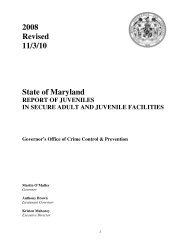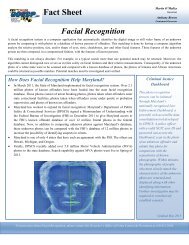Targeted Outreach - Governor's Office of Crime Control & Prevention ...
Targeted Outreach - Governor's Office of Crime Control & Prevention ...
Targeted Outreach - Governor's Office of Crime Control & Prevention ...
You also want an ePaper? Increase the reach of your titles
YUMPU automatically turns print PDFs into web optimized ePapers that Google loves.
Appendices 55<br />
procedures. A new member orientation was added and<br />
new members were required to bring a parent with them<br />
to meet with staff members. Staff also participated in a<br />
training program on how to respond to various emergency<br />
scenarios. Because the Getting Out program is separate<br />
from the rest <strong>of</strong> the Club, most activities do not take place<br />
on site. Therefore, the Club did not have to make major<br />
changes to accommodate it.<br />
Boys & Girls Club <strong>of</strong> Manatee County: The<br />
Brandenton and Palmetto Clubs<br />
Goals<br />
The goals <strong>of</strong> <strong>Targeted</strong> <strong>Outreach</strong> at the Bradenton and<br />
Palmetto Clubs, as reported by staff, are:<br />
• To help youth be successful in school and keep them<br />
out <strong>of</strong> the justice system;<br />
• To provide a good, positive atmosphere for youth to<br />
grow stronger; and<br />
• To make a difference in the lives <strong>of</strong> troubled youth.<br />
No staff person mentioned gangs, reflecting the preventive<br />
approach used by the Clubs, who tend to recruit youth from<br />
elementary schools, prior to their involvement with gangs.<br />
Gang Problem<br />
According to police personnel, there are five gangs in<br />
Manatee County, mostly territorial Hispanic gangs.<br />
Reportedly, there is more gang crime in Bradenton than<br />
in Palmetto, the two areas in which the Clubs are situated.<br />
Gangs in the area are most prevalent at the high school<br />
level, among youth age 14 and up.<br />
History and Development <strong>of</strong> the Initiative<br />
In 1996, the executive director submitted a proposal to<br />
BGCA for funding to implement GPTTO. A key objective<br />
was to help the organization refocus on its mission to serve<br />
all youth, including those exhibiting negative behaviors.<br />
When the Clubs received funding, they held a communitymobilization<br />
meeting with law enforcement personnel and<br />
school representatives. In light <strong>of</strong> the anticipated demands<br />
<strong>of</strong> targeted outreach, a director <strong>of</strong> operations position was<br />
created. This staff member’s primary responsibility is to<br />
respond to the increased paperwork and cross-Club cooperation<br />
that results from GPTTO.<br />
The main obstacle to getting GPTTO <strong>of</strong>f the ground was<br />
getting buy in from staff. They had to change their perceptions<br />
<strong>of</strong> gang youth, and to agree to work with them. At<br />
the beginning <strong>of</strong> GPTTO, the staff’s attitude was “we don’t<br />
deal with gang kids, we deal with good kids.” But the executive<br />
director and director <strong>of</strong> operations emphasized that<br />
the mission was to work with all kids, and eventually the<br />
staff came around.<br />
The Club also found it very difficult to secure outreach<br />
coordinators; they had hired and lost two to three people<br />
before they hired the current coordinators. The Clubs also<br />
found it challenging to develop relationships with law<br />
enforcement. Palmetto had at least three different police<br />
liaisons in the year prior to our interview. Still, Palmetto<br />
had more luck building a relationship with the police<br />
department than did Bradenton. As a result, Bradenton<br />
has focused almost exclusively on schools. Schools were<br />
easier for both Clubs to form relationships with, largely<br />
because several schools had former Club employees, and<br />
in one case the principal was a former board member.<br />
Recruitment and Referral<br />
At the time <strong>of</strong> our visit, the recruitment process consisted<br />
almost exclusively <strong>of</strong> school referrals and the inclusion <strong>of</strong><br />
current Club members. The school referral partners cultivated<br />
by the Manatee County Clubs have been able to supply<br />
them with more than 50 youth per Club. Club staff<br />
took advantage <strong>of</strong> these relationships and met with teachers,<br />
principal, and counselors, and ate with kids in the<br />
cafeteria as part <strong>of</strong> a recruiting effort.<br />
Teachers and principals from elementary schools indicated<br />
they refer youth who have no after- school supervision,<br />
need social development or peer relationship skills, and<br />
need good role models.<br />
The relationship between police and the Clubs has not<br />
been as strong as the Club would like, a situation that can<br />
be attributed to staff turnover among police. We met with<br />
a police <strong>of</strong>ficer who was new to the Club board and who<br />
felt that the development <strong>of</strong> a relationship was promising.<br />
Staffing, Intake and Tracking<br />
The outreach coordinator at Palmetto stated she seeks to<br />
involve kids who are in trouble. To determine a youth’s<br />
needs, she sometimes asks the youth directly, or asks<br />
another Club employee to whom the youth may have<br />
opened up. Sometimes she gets information from the<br />
teachers or other school personnel who referred the youth.<br />
The Bradenton outreach coordinator stated that she looks<br />
for kids in trouble based on “the area that they live in, kids<br />
with unsupervised time, behavior problems and low<br />
grades, from low-income and single parent households.”<br />
She asks kids directly what their needs and interests are,<br />
but lets the parents fill out the first two pages <strong>of</strong> the intake<br />
form that identify risk factors.<br />
The outreach coordinator at each Club had a case load <strong>of</strong><br />
50 kids, for whom she was responsible for completing all <strong>of</strong><br />
the intake and tracking. The outreach coordinator is also<br />
responsible for outreach to youth, contact with school, parents<br />
and police. The director <strong>of</strong> operations reviewed all <strong>of</strong>

















